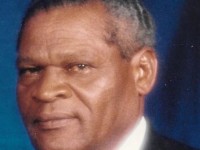ARTIST/BAND /GROUP INFORMATION
| Artist/Band/Group Birthday : | 24/06/1930(Age 85) |
| Born In/Current Location : | Croix-des Bouquet/ Florida |
| Genres : | Compas Direct |
His real name Jean Emmanuel Jabouin, Talès was born at the Croix-des Bouquets on June 24, 1930. He is the son of Cayen Emmanuel Jabouin, former civil servant, and Indiana Victor, originally from the Croix-des-Bouquets. At the age of 3, Talès was struck by typhoid fever, which left him with a slight paralysis of the legs. Shortly after his recovery (around four or five years old), he began to show an interest in music. Not without laughing, he says: “I enjoyed sitting on the” manoumba “when the troubadours who came to perform almost every weekend in the courtyard of my parents’ house were taking their break … These performers themselves- even enjoyed watching me pinch the blades of this instrument which was larger than me. ”
In 1937, Talès’ mother moved and moved with her son to rue du Champ-de-Mars, almost around the corner from rue de l’Enterrement, in the heart of Le Morne-à-Tuf. The neighboring house is that of the Augustin Baron couple, where the legendary pianist and musician François Alexis Guignard (often called Père Guignard) often plays. During the week, he makes saxophones from papaya stems which he plays, he says, with great joy for the neighbors. In October 1941, Talès was admitted to the Central School of Arts and Crafts where he learned music and the trumpet under the direction of maestro Augustin Bruno.
In July 1947, Talès, fresh from the Centrale, made its debut with the Ensemble Anilus Cadet, whose headquarters are at rue de l’Enterrement, opposite the Hospice Saint François de Sales. He then played alongside Fritz Ferrier, Issalem “Sonson” Bastien and other performers whom Anilus recruited if necessary. In September 1949, Talès occupied one of the ten music stands of Caribbean Jazz. It is this orchestra, edited by Issa El Saieh, who, in February 1950, accompanied Daniel Santos, Estela “Tete” Martinez and other Latin American stars visiting the “Simbie Night Club”, the “Vodou Night Club” and in other port-au-princiennes nightclubs. We take from him this astonishing confidence to say the least: “It is within the Caribbean Orchestra that I can retrace my best memories on the musical scene …” After the dislocation of this tenor, Talès joins again the group of Anilus Cadet, which obtains the second price of the 1951 carnival for the “Bèl carnaval” meringue. (The first prize was awarded to TI-TA-TO.)
At the same time, Talès, Emmanuel Duroseau fils (piano), Montfort Jean-Baptiste (double bass), Louis Denis (drums) and Marcel Jean (drum) will lend their talents to Guy Durosier, who, on the recommendation of Issa El Saieh, conducts the Tabou Ensemble, the sextet of the Hôtel Rivoli (Pétionville). During the same period, Talès accompanied the troubadour Nicolas “Candio” Duverseau, great cantor of Magloirism, in the four corners of the country. He also plays in other second-hand groups which animate Sunday picnics and dance evenings organized most often by Stanislas Henry and Antoine Dextra at Carrefour Marin, commune of the Croix des Bouquets.
At the end of 1951, Talès joined the Junior Atomic Orchestra, set up by Nemours Jean-Baptiste after his separation from the Atomic Orchestra. During 1952, the Nemours group was dissolved. The hot maestro was immediately called upon to conduct the Citadel Orchestra. When Hector Lominy separated from this orchestra, Talès was hired to assist Jean Moïse. A veritable builder, Nemours set up a small group at the same time to “climb the coast”, to use the expression of the time. With Dérico (singer), Webert Sicot (alto saxophone), Gérard Dupervil (trumpet), his brother Montfort Jean-Baptiste or sometimes Augustin Fontaine (double bass), Hilaire or sometimes “Bibiche” (drums) and other musicians, he furrows by mountains and valleys the nooks and crannies of the Republic, especially to animate country festivals.
In November 1953, Talès took the road to the Casino International and joined the Conjunto Panamerican led by trumpeter Emile D. Dugué. He then worked alongside Ulysse Cabral (singer), Julien Paul (double bass), Charles Dessalines (alto saxophone), Gabriel Dasque (drum), etc. About six months later, Talès departs from this group to replace Kesnel Hall in the Atomic Orchestra, then placed under the baton of pianist Robert Camille. He spent less than six months there and returned to the Citadel Orchestra to succeed Gesner Domingue.
Towards the end of 1954, Nemours Jean-Baptiste, still master of the Citadel Orchestra, founded the Conjunto International. To help him cheer up the customers of Jean Lumarque’s dancing restaurants, including one in Kenscoff, the other in Carrefour, he invites several musicians, including Talès on trumpet, to participate in this wonderful adventure: Dérico (singer) , Mozart Duroseau (accordion), Montfort Jean-Baptiste (double bass), Webert Sicot (alto saxophone), sometimes Gary Labidou (alto saxophone) and Kreutzer Duroseau (drum). On March 22, 1955, after the expansion and fitting out of the night club “Aux Calebasses” at Carrefour, “Le Conjunto” officially became “Ensemble Aux Calebasses”. It should be recalled that the date of July 26, 1955 was symbolically retained as that of the foundation of the musical formation of Nemours Jean-Baptiste, ancestor, therefore, of the direct compass. Talès will be the first and only trumpeter until the arrival of Walter Tadal in 1956.
When, in September 1958, Nemours left “Aux Calebasses” to go and perform at “Palladium Night Club”, by Sénatus Lafleur, he baptized his group with his name: Super Ensemble Nemours Jean-Baptiste. “So, says Talès, the direct compass will come into being”, a musical genre of which he was one of the great craftsmen, together with Walter Tadal, Raymond Gaspard, Julien Paul, Louis Lahens, André Boston and many other musicians . On this point, it is fitting to hear the voice of Talès to better inform us: “When we talk about direct compass, we must admit that Kreutzer Duroseau was the real catalyst of this movement … Richard Duroseau represents the very soul of the compass direct… ”(Interview with Louis Carl Saint Jean, October 22, 2005.)
On July 5, 1964, the Super Ensemble Nemours Jean-Baptiste began a tour of the United States. On September 22, the date of the group’s return to Haiti, our trumpeter, in perfect agreement with Nemours, said goodbye to the direct compass. He is replaced by the brilliant Jeremian trumpeter Emilio Gay. From the beginning of 1965, Talès began his career in the United States. On the recommendation of the excellent saxophonist Charles Dessalines, he joined “Los Ases del Sesenta” who play at Broadway Cafe, Myrtle Avenue, Brooklyn. He stayed there until March – April 1977. Less than a month later, he entered the Conjuto of the Cuban singer Monguito Guillan (known as “El Unico”) where the double bass player Fritz Grand-Pierre also played. Subsequently, Talès and Raymond Marcel sometimes play with ” Enrique Rosa y La Sabrosa ” sometimes with Johnny Dupre y su Orquesta Internacional. In 1980, Talès ended his musical career after spending two wonderful years with the group of Dominican singer Rafael Batista.
Apart from having been a talented trumpeter, Talès was also a fine and lucid analyst of the Haitian musical question. If he recognizes in Nemours Jean-Baptiste “an extraordinary maestro and a great visionary”, his favorite musicians have always been: Antalcidas O. Murat, Guy Durosier, Murat Pierre, Michel Desgrottes, Raoul Guillaume, Richard Duroseau and Webert Sicot. Besides, like Nemours Jean-Baptiste himself, Talès has always seen in Antalcidas Murat “a master”. In addition, he never went through four paths to affirm: “I am Haitian before being a musician […] It was an honor for me to have played in the group of Nemours for almost fifteen years. However, I must admit that the Youth Jazz was, by far, the biggest musical ensemble in the country… It is the Youth Jazz which played the real music of the country … ”(Interview with LCSJ, October 25, 2005). Hubert François, Jean Moïse, Alphonse Simon, Raymond Sicot and André Déjean were his idols among our trumpeters.
If Talès was known as a very good musician, he also enjoyed the reputation of an excellent father. While pursuing his career as a musician, he worked as a barber for over two decades at a hair salon in Sterling Place, Brooklyn. He thus provided the education for four wonderful children given to him by his wife Denise Frédéric Jabouin, whom he married in 1953: Reynald Jabouin, doctor of medicine (died in New York in January 2015); Patrick Jabouin, real estate agent and doctor of Theology; Fanya Jabouin Monnay, doctor of marital and family therapy and Jean Emmanuel Jabouin, Jr., MBA in Marketing.
After having traveled without sinking our immense space, Talès rests from his marvelous works since October 3, 2015 at the Forest Lawn Cemetery, in Fort Lauderdale, in Florida. For his follower Raymond Marcel: “Talès represented the model of a faithful friend … The suave sound of his playing had made him one of our best trumpeters. For his part, his former comrade Serge Simpson, second accordionist and first and only vibraphonist of the Super Ensemble Nemours Jean-Baptiste, greeted him: “A man of exemplary behavior. Talès’ trumpet playing, Simpson continues, reflected two qualities rarely found in one person: discipline and good humor. I always kept a great respect for this musician … May the name of Jean Emmanuel Jabouin remain forever engraved in the memory of all those who loved Haitian music in general, the direct compass in particular.
Visits: 213

